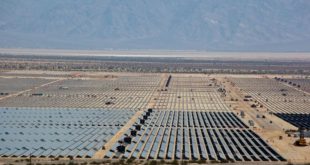Catching a nasty virus certainly isn’t on anyone’s holiday wish list, but for solar power it might be just what the doctor ordered.
With the help of a genetically modified virus, materials researchers at the Massachusetts Institute of Technology have found a way to boost the efficiency of one type of thin-film photovoltaic cell by 30 percent.
For years, engineers have experimented with a variety of unique collection material for solar cells, including single-walled carbon nanotubes: tiny hollow cylinders only a few billionths of a meter wide but with diamond-like strength. These carbon nanotubes, however, have been unproductive.
Part of the problem, scientists suspected, was that the processes for making nanotubes yield mixtures with different electronic properties—some carbon nanotubes are semiconductors, some are metallic.
A genetically engineered virus called M13 can be used to help rearrange molecules—for example, to make batteries more efficient.
But in the June 2011 issue of Nature Nanotechnology, Angela M. Belcher’s Biomolecular Materials Group at MIT announced an intriguing solution.
INNOVATION OUTBREAK
Over the past decade, Belcher’s laboratory has been exploring how viruses—embodiments of nature’s own nanotechnology—can solve problems in materials science and microelectronics.
Previously, the group has shown that a genetically engineered virus called M13 can be used to help rearrange molecules—for example, to make batteries more efficient.
Hoping to solve the nanotube challenge, members of Belcher’s lab altered M13 so that pieces of proteins, or peptides, on its surface could bind to carbon nanotubes.
By grabbing onto the nanotubes, the viruses stopped them from clumping, which allowed scientists to verify that the difference in electronic properties alone affected the nanotubes’ function. Semiconducting ones raised efficiency, whereas metallic ones degraded it.
PRACTICAL SOLUTIONS FOR THE FUTURE
The MIT group discovered that using the viruses with semiconducting nanotubes improved the efficiency of dye-sensitized solar cells by almost a third, from eight percent to 10.6 percent. That improvement isn’t gigantic in absolute terms, but it helps to make this variety of thin-film cell significantly more practical.
Because the virus-nanotube complexes can be treated simply as an additive to the normal solar-cell fabrication process, incorporating them into manufacturing should be relatively easy.
The researchers believe that this viral technique could be adapted to work with other types of solar cells. Dang, a PhD candidate in the lab, says that since submitting the Nature Nanotechnology paper for publication he has started a project to adapt the virus-nanotube technique for use in quantum dot solar cells and his colleagues have done the same with organic dye cells.
Moreover, according to Dang, several companies have already contacted them about acquiring the virus-nanotube technology. Because the virus-nanotube complexes can be treated simply as an additive to the normal solar-cell fabrication process, incorporating them into manufacturing should be relatively easy, he says.
AUTHOR BIO:
John Rennie is a science writer, editor and lecturer based in New York City. Between 2004 and 2009, he served as editor in chief of Scientific American. His writing has appeared in publications including The Economist, The New York Times and IEEE Spectrum. Since 2009, he has been an adjunct instructor in the graduate Science, Health and Environmental Reporting Program at the Arthur L. Carter Journalism Institute of New York University. Currently, Rennie writes “The Gleaming Retort” for the PLoS Blogs science blogging network. He has been a frequent guest on television and radio programs appearing on PBS, NPR, the History Channel and Discovery.
 Alternative Energy HQ solar power for homes, wind energy, and bio fuel issues
Alternative Energy HQ solar power for homes, wind energy, and bio fuel issues






